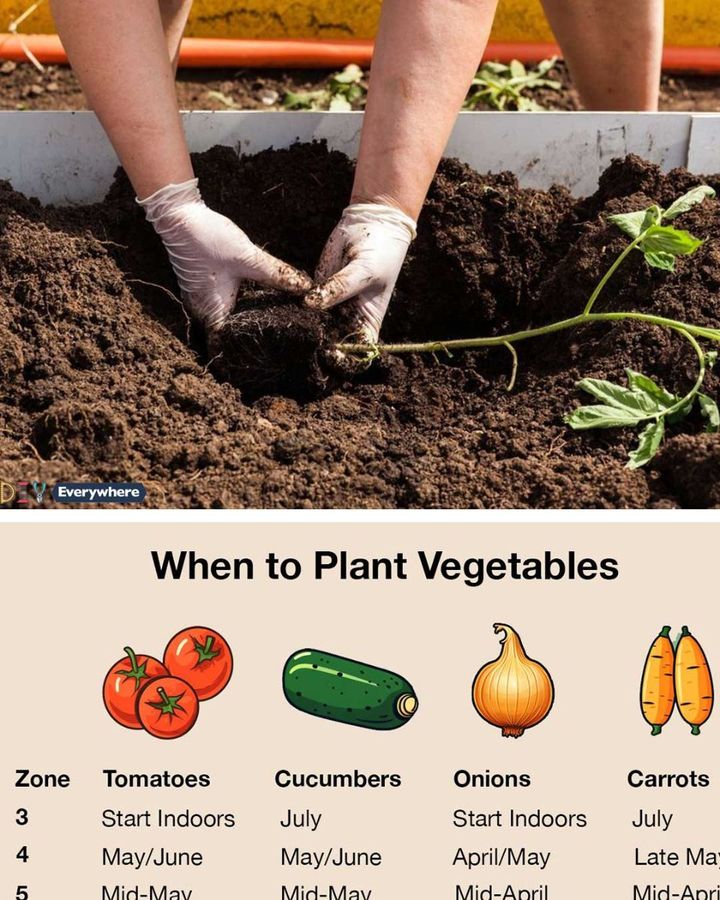Optimal timing for planting vegetables is paramount for a bountiful harvest. Ensuring that your plants experience the ideal growing conditions contributes to their health and productivity. Making informed decisions about when to plant based on climate, soil conditions, and specific requirements for each vegetable can significantly impact the success of your garden.
Strategically timed planting not only extends your growing season but also helps prevent issues like diseases and insect infestations, which can adversely affect plant health and yield. Armed with the right knowledge and a bit of planning, you can cultivate a thriving vegetable garden.
Consider these guidelines for specific vegetables:
Tomatoes:
Plant in late spring (May to June) to early summer (June to July) after the last frost date. Tomatoes thrive in warm soil and sunny conditions. Harvest fully ripe tomatoes in late summer (August to September) or early fall.
Onions:
A versatile vegetable, onions can be grown in various regions. Plant in early spring (March to April) or late summer (August to September) in well-drained soil with full sun. Harvest scallions at any growth stage, and mature onions in late summer (August to September) or early fall. Cure harvested onions in a warm, dry, well-ventilated area for improved storage and flavor.
Peppers:
Best planted in late spring (May to June) to early summer (June to July) after the last frost date. Peppers require warm soil and full sun. Harvest when mature, usually in late summer (August to September) or early fall.
Squash:
Plant summer squash like zucchini in late spring (May to June) to early summer (June to July). For winter squash like pumpkin, plant in late summer (July to August) for a fall harvest. Harvest summer squash in mid to late summer (July to August) when young and tender. Harvest winter squash in late fall (September to October) when the skin has hardened.
Carrots:
Plant in early spring (March to April) or late summer (August to September) in cool soil with full sun. Harvest when they reach the desired size and color, approximately 60 to 80 days after planting. For spring-planted carrots, harvest in late spring to early summer (May to June), and for late summer-planted carrots, harvest in late fall (October to November) or early winter.
Broccoli:
A cool-season crop, plant in early spring (March to April) or late summer (August to September). Broccoli thrives in moderate temperatures and partial shade. Harvest when heads are firm and compact, but before yellow flowers open. For spring-planted broccoli, harvest in late spring to early summer (May to June), and for late summer-planted broccoli, harvest in late fall (October to November) or early winter.
The definitive manual on optimal planting times for vegetables and their cultivation rationale
Cucumbers
Cucumbers thrive in warm seasons and should be sown in late spring (May to June) after the last frost. They require full sun and well-drained soil for optimal growth. Harvest cucumbers when they attain the desired size, remaining firm and green, typically 50 to 70 days after planting, depending on the variety. Continuously harvest throughout the summer (June to August) until the vine’s vitality diminishes.
Lettuce
Lettuce can be planted either in early spring (March to April) or fall (September to October) when the soil is cool. It flourishes in moderate temperatures and partial shade. Harvest lettuce once the leaves are sufficiently large for use but before they turn bitter or begin to bolt, typically 30 to 70 days after planting, depending on the variety. For spring-planted lettuce, harvest in late spring to early summer (May to June), and for fall-planted lettuce, harvest in late fall (October to November) or early winter.
Beans
Beans, being a warm-season crop, are best planted in late spring (May to June) following the last frost. They demand full sun and well-drained soil for growth. Harvest green beans when the pods are young, tender, and before the seeds fully mature, usually around 50 to 60 days after planting. Continue harvesting throughout the summer (July to August) until the plants cease production.
Radishes
Radishes, thriving in cool seasons, can be planted in early spring (March to April) or late summer (August to September). They prefer cool soil and full sun. Harvest radishes when the roots reach the desired size, remaining firm and crisp, generally 20 to 30 days after planting. For spring-planted radishes, harvest in late spring to early summer (May to June), and for late summer-planted radishes, harvest in late summer (September to October) or early fall.
Beets
Beets can be planted in early spring (March to April) or late summer (August to September) when the soil is cool. They thrive in well-drained soil and full sun. Harvest beets when the roots attain the desired size, being firm and tender, typically around 50 to 70 days after planting. For spring-planted beets, harvest in late spring to early summer (May to June), and for late summer-planted beets, harvest in late fall (October to November) or early winter.








